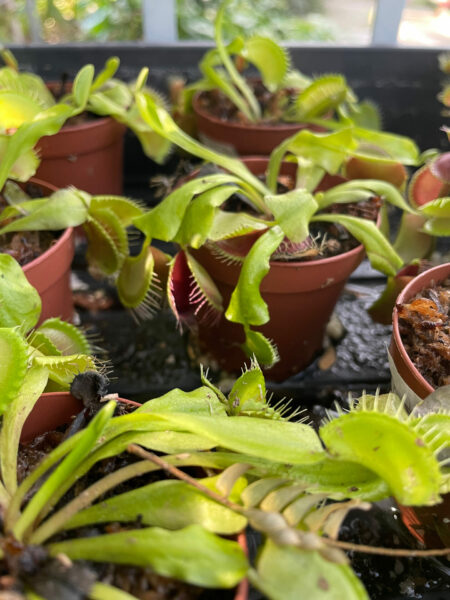Gardeners in cold winter climates should grow Venus flytraps in a moist environment — an open terrarium is ideal. Use captured rainwater or distilled water, not tap water!
Venus flytraps do best in at least six hours of bright sunlight per day. If your plant’s traps don’t show a pink interior or the leaves look long and spindly, provide more light.
Never add fertilizer or lime to the soil of Venus flytrap plants. These plants get the nutrients they need from their prey. Although flytraps are carnivorous, they can go for a month or two without eating insects. If you grow them outdoors, they’ll get enough to eat naturally. If you’re growing Venus flytraps indoors, you’ll have to feed them small bugs such as flies and beetles periodically. When you’re feeding a flytrap, don’t give it any insects larger than a third of the size of the trap. Otherwise, the trap won’t be able to fully close and begin digesting the food.
It doesn’t matter if the bug is alive or not, but the trap needs to be triggered by movement before it will close. For dead prey, after placing the bug in an open trap, gently touch a small paintbrush to the inside of the trap until you see the trap start to close. Only trigger traps to close when there is food for the plant. Playing with the traps just to make them close wastes the plant’s energy, which can lead to its decline.
This carnivorous plant is native to the temperate and subtropical wetlands of North and South Carolina. Although widely cultivated for sale, the population of the Venus flytrap has been rapidly declining in its native range. As of 2017, the species was under Endangered Species Act review by the U.S. Fish & Wildlife Service.
Flytraps need to go dormant in winter to continue to live and thrive year after year. A combination of exposure to shorter photo periods and colder temperatures from October to February triggers this dormancy. During dormancy many of the traps turn black and die back, others grow smaller and lower to the base of the plant. In spring the plant will begin to grow vigorously. Plants can be overwintered on a sunny windowsill in an unheated room or garage so long as temperatures do not dip below 20°F.
